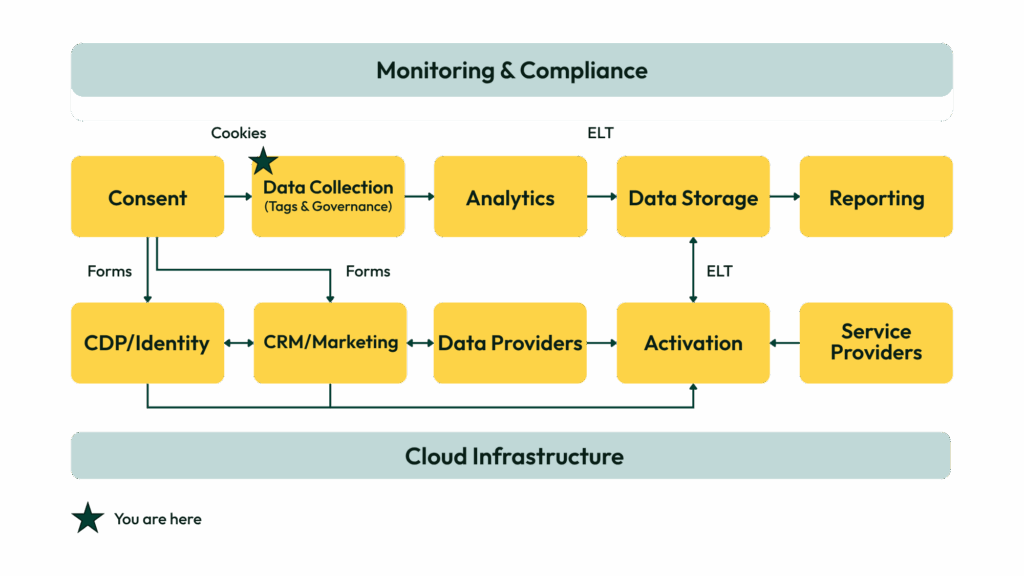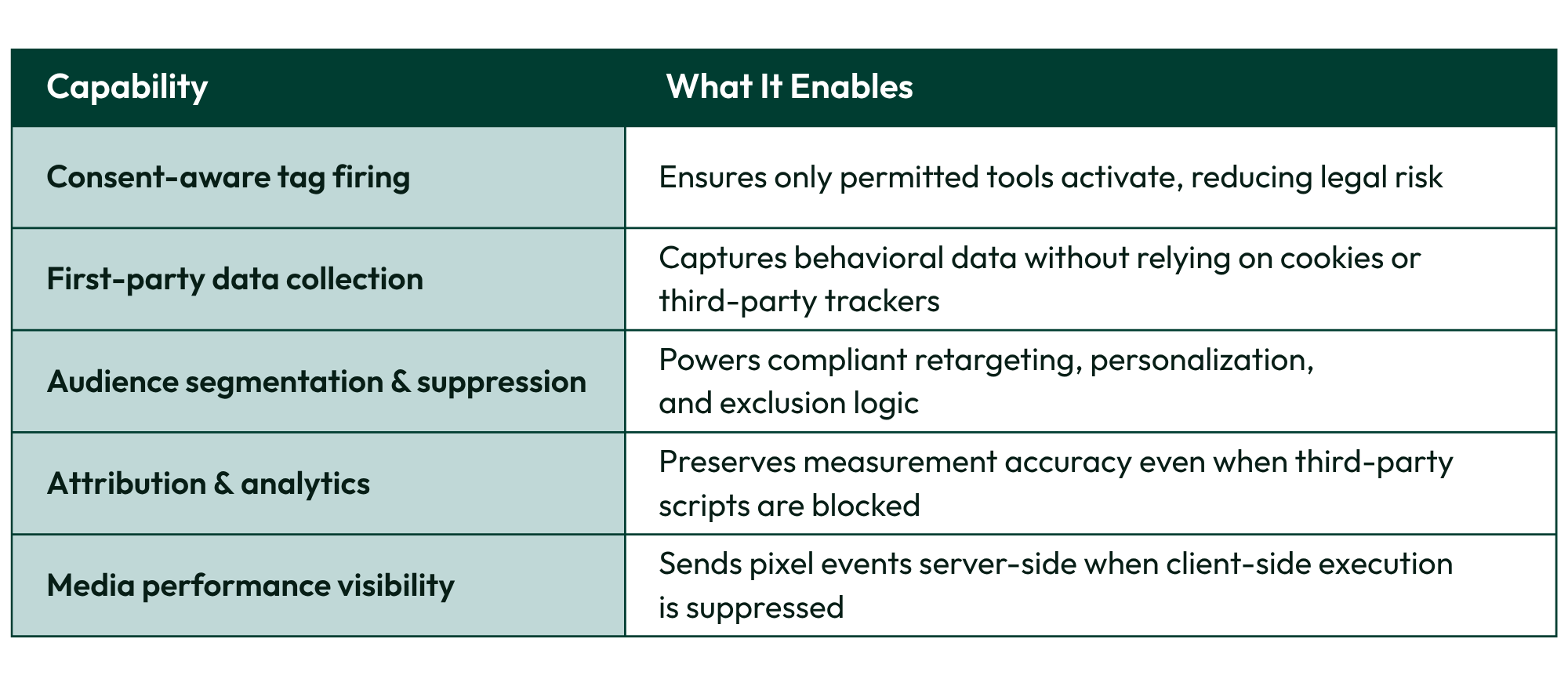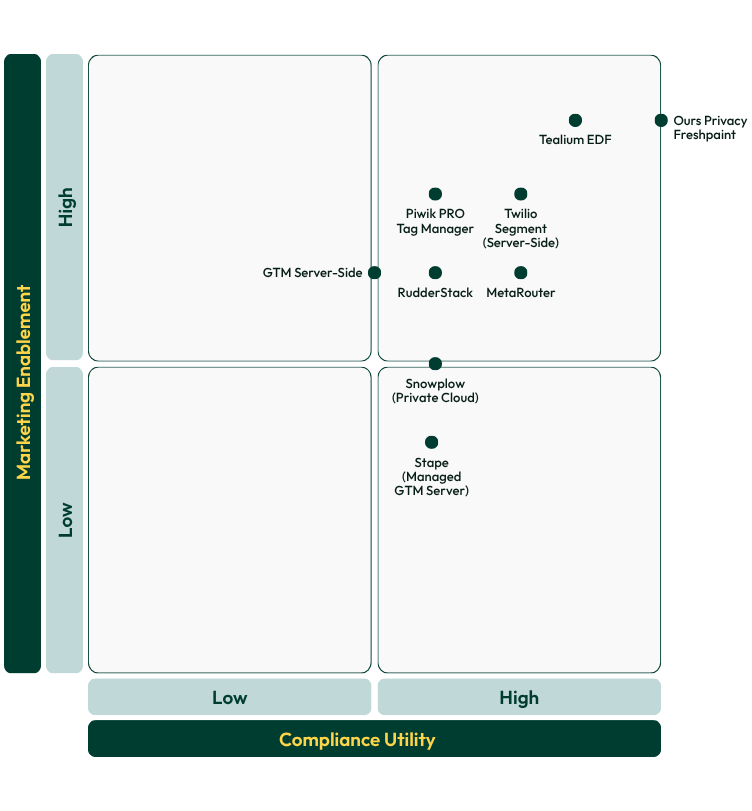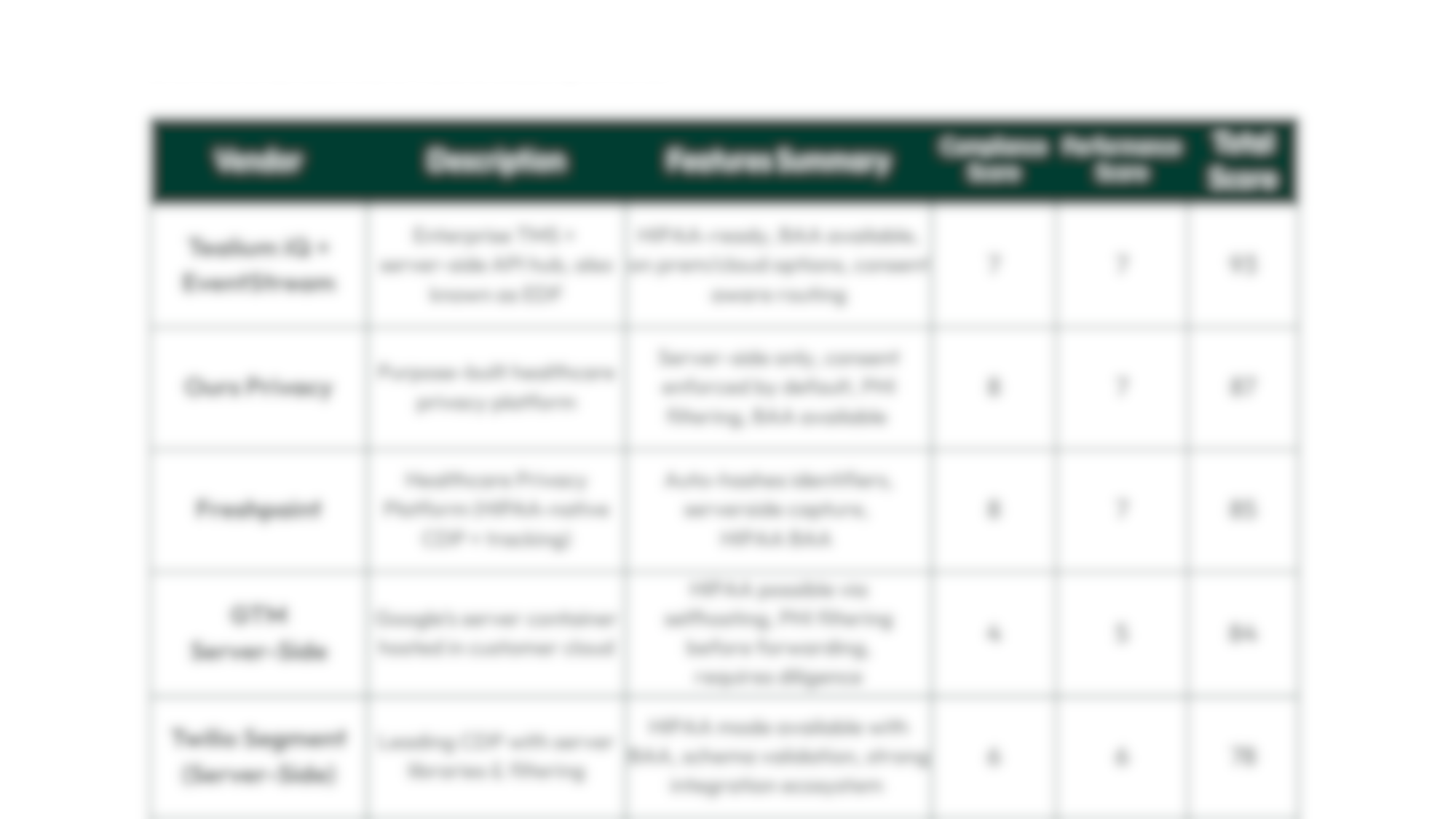The Ultimate Guide to Tag Management and Server-Side Tracking
Table of Contents
In 2022, two pivotal events reshaped digital marketing in healthcare.
Published on October 10, 2025
First, the Office for Civil Rights (OCR) at the Department of Health and Human Services issued new guidance that expanded the definition of Protected Health Information (PHI) to include Individually Identifiable Health Information (IIHI), data created when a personal identifier (like an IP address) is combined with health-related content a user views online. Under this interpretation, even a page visit to content about symptoms, conditions, or treatment could qualify as PHI, making nearly all third-party tracking a potential HIPAA violation.
That same year, The Markup published a groundbreaking investigation into how hospital and healthcare websites were sharing sensitive health information through third-party trackers. Their initial report in June, followed by an expanded investigation in December, revealed how widely embedded tracking technologies were capturing patient-related data and transmitting it to ad platforms. The combination of that public exposure and OCR’s new guidance triggered a wave of enforcement, litigation, and self-audits across the healthcare industry.
These developments marked a turning point: tag management and tracking are no longer purely technical or marketing functions. They are compliance infrastructure — central to how healthcare organizations safeguard privacy, preserve trust, and maintain the ability to measure and optimize digital performance.
Underlying this reckoning is 3rd-party tracking and data sharing. More specifically, it is client-side 3rd-party tracking and the rampant and often unintended sharing of IIHI with advertising, analytics and marketing platforms by HIPAA-covered entities that caught the attention of media, regulators, patients and ultimately, the legal community. And it is Tag management, the hidden engine that determines which tracking scripts fire, when they load, and what data they send to whom that provides the technical governance and operational rigor to support marketing performance while safeguarding patient data and protecting healthcare systems from regulatory, legal and brand risk.
In large part, it is for these reasons that server-side tracking has emerged as both a technical solution and a legal necessity. It enables privacy-safe data collection, reduces exposure to third-party leaks, and allows healthcare marketers to measure and optimize performance, without compromising compliance.
What You’ll Find Here and What You Won’t
This guide clarifies how Tag Management systems support both privacy enforcement and marketing operations in regulated environments. It is vendor-neutral, evidence-backed, and aligned to real-world healthcare marketing challenges. Keep an eye out for Wheelhouse-specific insights, points of view, and advice, as you move through the guide:





What Is a Tag Management & Server-Side Tracking Platform?
A Tag Management System (TMS) is the control panel for all tracking on your website or app. It dictates when and how scripts (“tags”) are deployed for analytics, media pixels, personalization tools, and more.
A Server-Side Tracking Platform shifts data collection from the user’s browser into a secure, controlled environment managed by your organization. When tracking occurs client-side, every pixel or third-party cookie on your site gives that vendor direct access, allowing them to decide what data is collected and where it’s sent (to their servers, not yours).
By moving tracking server-side, three key things change:
- You control what data is collected.
- You control where it’s sent: to your own servers or HIPAA-eligible cloud environments.
- You control what data is allowed to continue on to third parties through a secure, API-level connection.
This shift fundamentally changes how behavioral data is captured, processed, and protected. It reclaims ownership of your organization’s behavioral data and redefines how measurement, attribution, and optimization operate in a compliant, first-party framework.
In healthcare, these platforms are now both a means to help manage tags on a website and compliance-critical infrastructure. They determine whether patient interactions remain private, whether Protected Health Information (PHI) is inadvertently leaked, and whether marketing systems operate within regulatory bounds.
In Practice, These Platforms Should:
- Load or block analytics, media, and personalization tags based on real-time consent and risk logic
- Provide visibility and control over every data signal leaving the browser or app
- Enable data minimization by filtering or transforming payloads before transmission
- Support HIPAA-safe server-side environments that isolate PHI from third-party exposure
Why Tag Management & Server-Side Tracking Matter in Healthcare
Few industries face greater scrutiny over data collection than healthcare. Every script, tag, and data payload is a potential privacy risk, especially when tags are managed through browser-side tools with no visibility into what they collect or transmit. In this context, tag management and server-side tracking aren’t just marketing tools. They are regulatory risk controls.
Tag governance and server-side tracking now sit at the center of the privacy-performance equation.
The wave of lawsuits that began in 2022 targeting healthcare providers over pixel tracking shows just how high the stakes have become. Tools like Meta Pixel, Google Analytics, and session replay scripts, often deployed through tag managers, have led to claims of unauthorized PHI disclosure under HIPAA. Despite disclaimers, opt-outs, or consent banners, healthcare organizations are still held liable for how tracking was technically implemented and the privacy violations that result from errors.
When implemented correctly, these platforms can:
- Prevent unintentional PHI leakage by blocking risky tags or stripping sensitive data before transmission
- Enable marketing attribution and personalization without exposing identifiers to third parties
- Satisfy HIPAA’s “minimum necessary” and “reasonable safeguards” requirements in technical architecture
- Reduce reliance on browser-side tools, which are more susceptible to leaks, interception, and audit failure
In healthcare, “what gets tagged” is not just a technical question. It’s a legal one. And the only reliable way to enforce tagging policy at scale is through a platform that can audit, control, and transform data before it ever leaves your system.
Role in the Healthcare Stack
In privacy-regulated healthcare environments, Tag Management Systems (TMS) and Server-Side Tracking Platforms don’t just manage data flows, they determine whether compliant, performant marketing is even possible.

Data Collection Position
Sitting in the data collection layer, these tools govern how behavioral data is captured, where it is processed, and whether that process aligns with patient consent and HIPAA requirements. As such, they sit at the convergence of regulatory enforcement and marketing enablement, shaping everything from campaign measurement to personalization and retargeting.
Tag Management vs. Consent Management: Who Comes First?
The ideal setup puts your Consent Management Platform (CMP) first. It captures user preferences before any tag loads. Then, your Tag Management System reads those signals and fires (or suppresses) tags accordingly.
In practice, some stacks invert this flow, where the tag manager loads the CMP. This introduces race conditions that can expose PHI before consent is registered. It may be technically feasible, but it’s rarely compliant.
Done right, tag management and server-side tracking unlock powerful capabilities for healthcare marketers operating in privacy-first environments:

Core Capabilities
Your TMS and server-side platform must do more than route tags. They must enforce compliance, preserve data quality, and enable high-performing marketing in a privacy-first environment.
Here are the six foundational capabilities that define a healthcare-grade tracking and tag governance solution:
1. Tag Deployment & Governance
Centralized control over all tags across environments (dev, staging, production)
2. Conditional Tag Firing
Allow/block tags in real time based on consent, behavior, or risk logic
3. Server-Sider Routing
Move sensitive tag execution off the browser to a HIPAA-ready server
4. Data Filtering
Suppress or transform identifiers, URLs, query strings, and PHI-adjacent fields
5. Consent Integration
Connect directly with CMPs to enforce privacy before data is collected
6. Audit Logging
Track every tag action with immutable, timestamped logs for compliance reviews
Compliance Requirements
In HIPAA-regulated environments, these platforms must be explicitly designed to prevent the collection or transmission of Protected Health Information (PHI) without consent.
To be viable in healthcare marketing, your tag governance stack must meet the following compliance expectations:
1. Business Associate Agreement (BAA)
- Any platform that touches PHI or PHI-adjacent data must be covered by a BAA. This includes cloud-hosted tag managers, server-side endpoints, or orchestration layers.
2. Consent-Based Tagging
- Tag firing must be conditioned on real-time consent captured through a CMP.
- “Always-on” tracking is not compliant, even for common tools like analytics, media pixels, or chat widgets.
3. Data Minimization & Filtering
- Platforms must support field-level filtering and redaction of sensitive data.
- Identifiers like page URLs, user IDs, form inputs, or device fingerprints should be suppressed or anonymized where applicable.
4. Audit Trail Maintenance
- Every tag load, suppression action, or data transmission must be logged.
- Audit logs should be immutable, timestamped, and exportable for compliance review or breach investigation
5. Server Ownership & Infrastructure Controls
- Server-side tracking must occur in HIPAA-compliant cloud environments with encryption and access controls.
- Server environments should be isolated from public internet traffic and configured with secure ingress/egress rules.
Market Landscape
The tag management and server-side tracking market continues to mature, driven by privacy regulations, browser restrictions, and the growing demand for first-party data. In healthcare, the key differentiators are HIPAA readiness, BAA availability, server-side execution, and PHI filtering.
We break the category into five primary approaches, each represented by leading vendors in the space.
Full-Stack TMS with Native Server-Side Hub
Vendors in this group combine marketer-friendly tag deployment with a first-party, server-side hub. They give healthcare marketers a single platform to manage both client-side tags and server-side event routing.
- Tealium – Enterprise-grade, HIPAA-ready TMS with EventStream server-side capabilities. Supports masking, consent gating, and minimum necessary forwarding. BAA available.
Privacy-First Platforms Built for Healthcare
These vendors are purpose-built for HIPAA and privacy-first industries. They operate with consent enforcement and PHI filtering as defaults, not add-ons.
- Ours Privacy – Healthcare-specific orchestration layer that integrates consent with server-side tracking. BAA available.
- Freshpaint – Designed as a “Healthcare Privacy Platform,” capturing events and automatically deidentifying data before sending downstream. HIPAA focus by design.
Server-Side Containers and Managed Hosting
For teams already invested in Google Tag Manager, these vendors enable server-side deployment, shifting execution from the browser into controlled, HIPAA-eligible environments.
- GTM Server-Side – Deployable in your own HIPAA-compliant cloud environment. Supports filtering, pseudonymization, and secure forwarding. No BAA from Google, so compliance depends on configuration.
- Stape (Managed GTM Server) – Managed hosting service that helps healthcare teams deploy and maintain GTM server containers on HIPAA-ready cloud infrastructure.
Data Pipelines and Event Routers
These platforms specialize in event governance, offering schema enforcement, payload filtering, and secure routing. They give engineering teams fine-grained control over how and where PHI flows.
- Twilio Segment – Marketing-leading CDP with robust server-side pipelines, filtering, and HIPAA eligibility under Twilio’s BAA.
- RudderStack – Open-source alternative with HIPAA-ready, self-hosted deployments. Strong transformation features for PHI suppression.
- MetaRouter – Privacy-focused event gateway that runs in customer-owned environments. Built for regulated industries, with PHI filtering by default.
Analytics Suite with Integrated Tag Manager
Some platforms embed tag management directly within privacy-first analytics stacks, offering marketers a more controlled alternative to Google Analytics.
- Piwik PRO – Analytics + tag management suite with HIPAA-friendly hosting options. Supports consentaware triggers and private data storage.
First-Party Event Collection Pipeline
For organizations with strong engineering capacity, these tools allow full control of data pipelines, collecting first-party data into HIPAA-eligible environments before deciding what to share externally.
- Snowplow – Open-source analytics pipeline deployed in your own private cloud. Supports data enrichment, pseudonymization, and full ownership of raw event data.
Evaluation Framework
Selecting the right tag management or server-side tracking platform in healthcare requires more than a feature comparison. It means assessing each vendor on their ability to both enforce HIPAA compliance and enable marketing performance.
Our evaluation framework weighs five core categories, with criteria designed specifically for regulated healthcare environments:
Privacy & Compliance (30%)
- BAA availability (standard or case-by-case)
- Pre-consent blocking of all tags/scripts
- PHI suppression, anonymization, and payload filtering
- Audit-ready logging and long-term retention
- Compliance with HIPAA, CPRA, GDPR
Healthcare Fit (25%)
- Proven deployments in hospitals, health systems, or telehealth
- Ability to support consent-based event collection in HIPAA environments
- Configurations to prevent accidental PHI transmission (URLs, identifiers)
- Documentation or case studies for regulated industries
Architecture & Flexibility (20%)
- Support for both client-side and server-side orchestration
- Deployment options: SaaS, on-prem, or customer-hosted VPC
- API-first design for extensibility
- SDKs for mobile and app tracking
- Compatibility with composable healthcare MarTech ecosystems
4. Tag Enforcement & Data Control (15%)
- Consent-aware tag firing across environments
- Schema validation and payload filtering before transmission
- Ability to drop, mask, or transform identifiers
- Event routing to only HIPAA-eligible destinations
Usability & Support (10%)
- User-friendly tag interface for non-technical teams
- Documentation, training, and dedicated healthcare support
- Implementation resources and roadmap for regulatory evolution
- Ability to manage governance across multiple sites/apps
TMS Vendor Scorecard
To support direct comparison and procurement decision-making, we’ve translated the evaluation rubric into a vendor scorecard. This table summarizes how each vendor performs across privacy, performance, architecture, healthcare fit, and usability criteria.
Dual Utility Compliance vs. Performance
Tag management and server-side tracking platforms are often evaluated primarily on their compliance posture. That makes sense in healthcare, where preventing PHI exposure is non-negotiable. But looking only at compliance overlooks a critical dimension: performance utility.
These platforms are not just privacy firewalls, they are marketing enablers. By shifting data collection serverside, they restore reliable attribution, allow consented personalization, and make first-party data strategies resilient against browser restrictions and adtech disruption. In other words, the right solution doesn’t just keep you safe, it keeps your campaigns measurable, optimizable, and scalable in a privacy-first world.
Navigating the Compliance-Performance Tradeoff
The best solutions don’t just block risk. They enable marketers to collect, transform, and activate data in a way that drives measurable ROI while staying compliant.
Compliance Utility
- Availability of a BAA
- Consent-aware tag firing
- PHI filtering and payload suppression
- Immutable audit logs
- HIPAA-ready hosting options
Performance Utility
- Server-side orchestration for attribution and personalization
- Integration with analytics, CDPs, CRMs, and ad platforms
- First-party data collection resilience against browser restrictions
- Marketer-friendly workflows for deployment and governance
The matrix reveals four quadrants:
- Top-right (High Compliance, High Performance): Tools that support privacy enforcement and marketing flexibility
- Bottom-right (High Compliance, Low Performance): Strong privacy tools that don’t directly contribute marketing utility
- Top-left (Low Compliance, High Performance): Tools that are exclusively focused on marketing performance, and that require high levels of support or configuration to be compliant.
- Bottom-left (Low Compliance, Low Performance): Should be avoided entirely in HIPAA-regulated settings
TMS Vendors: Privacy vs. Performance

Implementation Guidance
Implementing tag management and server-side tracking in healthcare is not just about standing up a platform. It’s about building a governance model that ensures compliance and enables performance at scale. Tools matter, but what matters more is how they’re deployed, integrated, and owned across teams.
Core Principles for Implementation
Step 1: Integrate Consent and Tagging from Day One
Consent enforcement and tag orchestration must be designed together. If consent logic lags behind, tags will fire prematurely, exposing PHI. Architecture decisions here determine whether your compliance posture holds.
Step 2: Define Ownership and Coordination
Decide who owns each piece of the stack—marketing, IT, analytics, compliance. Fragmented ownership leads to inconsistent tracking, hidden risks, and technical debt.
Step 3: Prioritize Governance Over Convenience
Server-side is not a shortcut. It is privacy infrastructure. Shortcuts like placing a CMP outside of a tag manager or misconfiguring GTM server containers can undo compliance efforts entirely.
Step 4: Implement Transparency Safeguards
Server-side tracking can reduce visibility for users and auditors if misused. Build clear audit trails, logging, and documentation to ensure accountability.
Step 5: Plan for Scale, Not Just Launch
Treat implementation as a foundation. Early investment in robust infrastructure (as Providence did) avoids costly rework when regulatory scrutiny or campaign complexity grows.
Implementation Tactics That Work
- Deploy CMP logic before tag management to eliminate race conditions.
- Stand up a QA environment where all tags point to test containers, catch misfires before they hit production.
- Monitor dynamically loaded scripts (like schedulers or chat tools) that can bypass consent controls.
- Ensure audit logs are immutable, timestamped, and exportable for compliance reviews.
- Evaluate vendor maturity, some platforms minimize infrastructure overhead (Freshpaint, OursPrivacy) while others require hands-on governance (GTM server-side, Adobe Launch).
Future Outlook
The role of tag management and server-side tracking in healthcare is poised for rapid evolution over the next 12–24 months. The drivers are clear: regulatory pressure, technical changes in browsers and platforms, and the shift to first-party data strategies. Together, these forces will redefine how healthcare marketers capture, govern, and activate patient engagement data.
1. Server-Side Becomes the Default
Client-side tags are becoming unreliable due to browser restrictions (ITP, ETP) and growing regulatory risk. The future of compliant measurement is server-side, where PHI can be suppressed, consent respected, and first-party data routed securely. Within two years, server-side tagging will move from “advanced” to expected in healthcare marketing stacks.
2. CMP + TMS Convergence
Consent enforcement and tag orchestration are increasingly intertwined. Expect deeper integration, or more likely native bundling, of Consent Management Platforms (CMPs) with TMS and server-side solutions. The future is a single privacy controlled platform, where consent signals automatically govern what data flows downstream for activation.
3. First-Party Data Warehouses as the Hub
Platforms like Wheelhouse DMG’s Compass demonstrate where the market is headed: server-side tagging feeds directly into HIPAA-compliant data warehouses, where all first-party signals are unified, audited, and activated. This shift positions the warehouse, not the tag manager, as the true system of record for compliant marketing data.
4. AI-Driven Governance and Optimization
Artificial intelligence will increasingly power both compliance and performance use cases. Examples include:
- Automated PHI detection and suppression in tag payloads
- Real-time anomaly detection for rogue or misfiring tags
- Campaign optimization engines that leverage only compliant, consented data
- AI won’t replace governance, but it will augment it, catching risks and opportunities at scale
5. Regulatory Expansion and Enforcement
OCR, FTC, and state AGs are not slowing down. New state privacy laws (e.g., Washington’s My Health My Data Act) expand the definition of health data and apply enforcement even outside traditional HIPAA boundaries. Healthcare marketers must prepare for a future where every tracking decision is auditable, and where noncompliance means not only fines, but reputational damage and ad platform restrictions.
Hard Truths from the Field
- A promising server-side implementation faltered because consent wasn’t tightly coupled with tag management. The result? Race conditions where tags sometimes fired before preferences were enforced. Lesson: consent and tag governance must be architected together, not separately.
- A CMP-first deployment gated some pixels effectively, but left other scripts firing uncontrolled client-side. The audit showed how quickly “shadow tags” creep in without centralized enforcement, underscoring why all data flows should be routed server-side.
About This Guide
This guide was created through a collaborative process that blended the speed and structure of AI with decades of real-world healthcare marketing experience.
We used AI tools to help us gather, synthesize, and organize foundational information about this category and the vendors included. These tools supported brainstorming, research structuring, and drafting early content sections. We also used AI to transcribe and analyze hours of interviews with our internal experts, vendor partners, and healthcare industry leaders, transforming those conversations into the practical insights shared throughout.
Every section was manually reviewed, edited, and enriched by our team to ensure accuracy, nuance, and relevance to healthcare marketers navigating complex privacy challenges. We refined the structure iteratively, using both AI suggestions and human judgment to create a guide that is clear, credible, and actionable.
While AI helped us work more efficiently, it’s the combination of technology and lived experience that gives this guide its depth and utility.
Created by Wheelhouse DMG
Resources
Legal Disclaimer: The information contained in this communication should not be construed as legal advice on any matter. Wheelhouse DMG is not providing any legal opinions regarding the compliance of any solution with HIPAA or other laws and regulations. Any determination as to whether a particular solution meets applicable compliance requirements is the sole responsibility of the client and should be made after consulting with their own legal counsel.
More Ultimate Guides
Explore our other Ultimate Guides to help you navigate your privacy-compliant MarTech needs.






